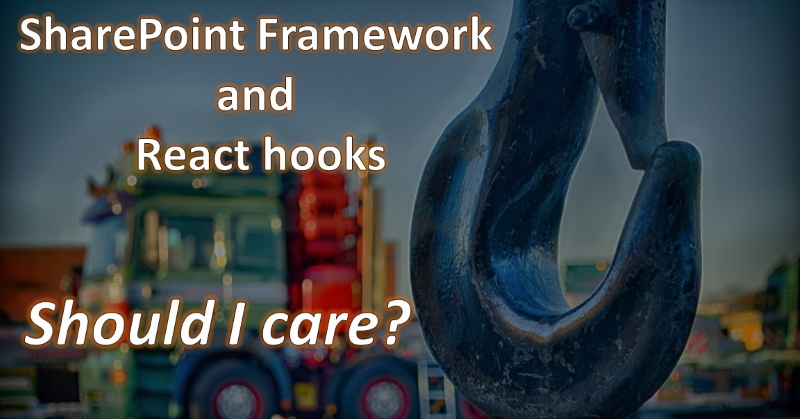
SharePoint Framework 1.9 introduced support for React 16.8+. While only a minor part of the version was changed (16.7 -> 16.8), it means a lot. It means that you can use the full power of React hooks. But should you? Obviously, the answer is yes, because React hooks introduce a lot of useful features, including:
- reuse stateful logic across your many React components, which isn't possible with class-based components
- get rid of high-order components, you can move some logic out of your React components into custom hooks. All that makes your code cleaner
- all your React components now are in the same style (you don't mix class-based components with functional). Instead, you use only functional components, because they support state (with help of hook of course)
There are even more reasons going to hooks, instead of class-based components. Check out official documentation from React:
Should I use Hooks, classes, or a mix of both?
....we’d encourage you to start trying Hooks in new components you write. ....In the longer term, we expect Hooks to be the primary way people write React components.
Hooks are available starting from February 2019. A lot of libraries adopted their code to hooks. You are on the safe side if you're planning to use hooks in your code today. More...

At the end of September 2019, Microsoft released The Graph Toolkit library.
a collection of reusable, framework-agnostic web UI components that work automatically with Microsoft Graph
It was in preview for a while, now it's in GA, thus it's a good time to start exploring what is available in this library.
First of all, that's a set of components, which abstract a lot of things about MS Graph, authentication, UI away from a developer. It provides a very seamless interface for building UI components. UI elements are built with web components technology - which means that they are framework agnostic. You can use it with any modern JavaScript framework.
Let's explore how to use this library with a React-based single page application and with SharePoint Framework. More...

Any version?
-Yes, any.
Including the latest versions of React, TypeScript, etc. ?
-Yes.
The problem
SharePoint Framework is supported not only by SharePoint Online but by on-premises SharePoint as well (2019 and 2016 with Feature Pack). SharePoint Framework Yeoman generator has different options for different SharePoint versions and it generates different project templates depending on the environment selection.
On-premises SharePoint is always behind SharePoint Online in terms of features and codebase. And the same issue applies to SharePoint Framework. If you generate a "Hello world" SharePoint Framework web part for SharePoint 2019, you will see that it uses React 15.6, TypeScript 2.4 and Office UI Fabric React (OUIFR) 5.21. The most recent versions (as of Sept. 2021) are React 17.x, TypeScript 4.x and OUIFR (now called Fluent UI React) 8.x.
Now you see the issue - you always have to work with an older version of packages. You miss a lot of potential features, bug fixes, and other things. Additionally, from a developer perspective, it's not exciting to work with outdated technologies or frameworks. Will Microsoft update yeoman generator for on-premises to add support to the most recent version of packages? I don't think so. On-premises are not in the priority list today.
For those who want to jump and explore the code right away - the full source code for this post is here at GitHub. More...